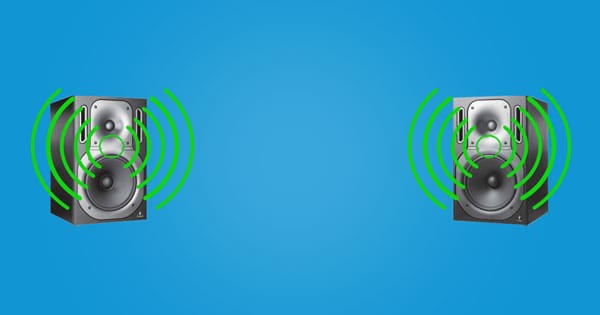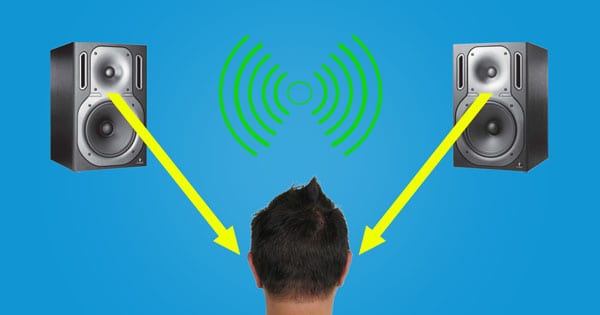The number of channels utilized to capture and playback audio is the difference between monophonic (mono) and stereophonic (stereo) sound.
A single audio channel is used to record and play back mono signals, while stereo sounds are recorded and played back using two audio channels.
The most evident distinction as a listener is that stereo sounds may provide the illusion of breadth, but mono sounds cannot.

Audio Files: Mono vs. Stereo
Stereo systems are playback systems that employ two speakers.
Left and right channel information is included in stereo audio files such as stereo MP3 and WAV files, and tells the left and right speakers when to push and draw air.
If you’ve ever looked at the waveform of a stereo audio file in a digital audio workstation (DAW), you’ll see that the file is split into two waveforms.
A single audio channel is represented by each waveform.

Figure 1: A stereo audio file is shown
There is just one audio channel in mono audio files.

Figure 2: A mono audio file is shown
Related: 10 Best RV Stereos of 2026
Playback in Mono vs. Stereo
Stereo systems have the ability to provide the appearance of sound source localisation.
The capacity of a person to find the location of a sound source inside an area is known as sound source localization.
If you hear a dog barking, for example, it’s quite simple to figure out where the sound is coming from and how far away the sound source (the dog) is.
Even with their eyes closed, most individuals should be able to locate sounds with reasonable precision.
It’s reasonable to believe that the sound generated by a stereo system comes from two separate sound sources: the left speaker and the right speaker.
You may hear sound coming from two separate directions in certain instances, although this isn’t always the case.

Figure 3: Two speakers produce sound.
The human brain is easy to deceive since it locates sounds using basic notions.
Timing discrepancies between sounds reaching your left and right ears, sound wave frequency, sound wave pressure levels, dynamic range, and reverberation quantity are all examples of these principles.
Stereo systems take use of your brain’s gullibility to provide the “impression” of sound source localisation between the left and right speakers.
Because the genuine sound sources (the speakers) are positioned out to the sides, you’ll perceive the source of the sound to be squarely between the speakers when the left and right speakers play the identical signal.
This is referred to as a phantom mono sound source.
Related: How To Find Ignition Wire For Stereo?

Figure 4: A phantom mono sound source is created by two speakers.
The left/right location of a sound is determined by sound wave timing discrepancies in your brain.
Sound waves from a sound source closer to your left ear will reach your left ear before reaching your right ear.
Even though the changes in time are minor, they assist your brain in locating the sound.

Figure 5: Sound waves travel a shorter distance to reach a person’s left ear than they do to reach their right ear, resulting in a delay.
When you use a second speaker to mimic this process and give both speakers the identical signal, your brain believes the sound source is in front of you.

Figure 6: A stereo playback method that gives the idea of sound source localisation
The sound they create will be regarded as broader if changes are added to one of the signals.
Width (X-axis) is one of the three dimensions that a stereo system can detect.
Height (Y-axis) and depth (Z-axis) are the additional dimensions (Z-axis).
These three dimensions combine to generate a stereo picture, which is a three-dimensional space.
The Art of Mixing by David Gibson does an excellent job at visualizing stereo image.
You can see and hear how track components have been placed into the stereo field of various tracks in the video below.
Note: The audio in the following video should be listened to with headphones or a stereo playback device.
If you’re listening to music via a stereo system, make sure your head is in an equilateral triangle with the speakers.
The stereo picture should be seen as intended if your speakers are tilted 45 degrees toward you.
Related: How To Install A Car Stereo?
The height at which you hear sound in a stereo field is determined by frequency.
Low-frequency noises are located above high-frequency sounds.
The hi-hats in a song, for example, will sound as though they are placed above the bass guitar.
The relative volume, dynamic range, and quantity of reverberation all influence the depth of a sound.
Sounds with a low volume and a small dynamic range, as well as sounds with a lot of reverb, are pushed to the rear of the stereo field.
Mono playback systems have just one speaker and can only generate a two-dimensional picture with depth and height.
To establish the directional time variations that your brain needs to sense breadth, you’ll need two speakers.
Related: How to Wire Car Speakers to the Radio Without the Harness?
Recording in Mono vs. Stereo
A single channel of audio is captured when a single microphone is used to record a sound source.
A single speaker or a pair of speakers may be used to play back a mono recording like this.

Figure 7: A mono recording of a guitar.
When mono sounds are played back over a stereo system, they are converted to dual-mono.
The audio from a single channel is duplicated and delivered to the left and right speakers.
Two microphones are required to get accurate stereo recordings.
You’ll need to pan one of the microphone recordings to the left and the other to the right when processing a stereo recording.

Figure 8: A stereo recording of a guitar.
A back-to-back comparison of a mono guitar recording versus a stereo guitar recording may be seen in Steven Law’s video below.
The X-Y approach is the stereo microphone technology he’s utilizing; it produces a relatively broad stereo picture that’s also mono compatible.
By angling the microphones more outward or utilizing various acoustic guitar recording methods, you may generate an even broader stereo picture.
Many portable recorders have the capacity to record in stereo, employing a pair of built-in microphones to capture sound.
The left microphone’s information is saved to the left channel of the saved audio file, while the right microphone’s information is saved to the right channel.
The Zoom H4N Pro has two microphones and can record in stereo mode.










